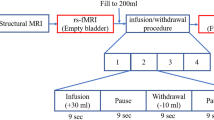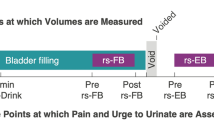Abstract
Aims
In order to observe central responses during naturally occurring urinary bladder storage in healthy subjects, we examined brain areas that control strong bladder sensation by resting-state functional magnetic resonance imaging (rs-fMRI).
Methods
All subjects were right-handed and scanned twice under the following two conditions: empty bladder and full bladder (‘strong desire to void’) without the use of filling with a catheter. Brain imaging software (DPARSF and REST) was adopted to analyze the difference in brain–blood perfusion between the two conditions. Voxel-based analysis of the regional homogeneity (Reho) maps between empty and full bladder was performed with a paired t test. Statistical maps were set at P value <0.05 and were corrected for multiple comparisons.
Results
The rs-fMRI scans of 30 healthy subjects (8 men and 22 women, between 24 and 49 years of age) were analyzed. The responses became stronger in the state of strong desire to void (P < 0.05). Increased activity during strong desire to void was observed in the prefrontal cortex (PFC), anterior cingulate cortex (ACC), hypothalamus, temporal lobes and left caudate nucleus, which are involved in bladder perception related to large volumes in adults.
Conclusions
There are significant changes in the brain’s Reho during the strong sensation to void. The results suggest that the PFC, the ACC, hypothalamus, temporal lobes and left caudate nucleus play a role in the cerebral control of bladder storage without artificial bladder filling in healthy people.



Similar content being viewed by others
References
Griffiths D, Tadic SD, Schaefer W et al (2007) Cerebral control of the bladder in normal and urge-incontinent women. Neuroimage 37:1–7
Blok BF, Willemsen ATM et al (1997) A PET study on brain control of micturition in humans. Brain 120:111–121
Athwal BS, Berkley KJ, Hussain I et al (2001) Brain responses to changes in bladder volume and urge to void in healthy men. Brain 124:369–377
Zhang H, Reitz A, Kollias S et al (2005) An fMRI study of the role of suprapontine brain structures in the voluntary voiding control induced by pelvic floor contraction. Neuroimage 24:174–180
Achard S, Salvador R, Whitcher B et al (2006) A resilient, low-frequency, small-world human brain functional network with highly connected association cortical hubs. J Neuro Sci 26:63–72
Fair DA, Schlaggar BL, Cohen AL et al (2007) A method for using blocked and event-related fMRI data to study ‘‘resting state’’ functional connectivity. Neuroimage 35:396–405
Anand A, Li Y, Wang Y, Lowe MJ, Dzemidzic M (2009) Resting state corticolimbic connectivity abnormalities in unmedicated bipolar disorder and unipolar depression. Psychiatry Res 171:189–198
Versace A, Thompson WK, Zhou D et al (2010) Abnormal left and right amygdala-orbitofrontal cortical functional connectivity to emotional faces: state versus trait vulnerability markers of depression in bipolar disorder. Biol Psychiatry 67:422–431
Margulies DS, Bottger J, Long X et al (2010) Resting developments: a review of fMRI post-processing methodologies for spontaneous brain activity. Magma 23:289–307
Chen HJ, Zhu XQ, Yang M et al (2012) Changes in the regional homogeneity of resting-state brain activity in minimal hepatic encephalopathy. Neurosci Lett 507:5–9
Zang Y, Jiang T, Lu Y et al (2004) Regional homogeneity approach to fMRI data analysis. Neuroimage 22:394–400
Zhong Y, Lu G, Zhang Z et al (2011) Altered regional synchronization in epileptic patients with generalized tonic-clonic seizures. Epilepsy Res 97:83–91
Dai XJ, Gong HH, Wang YX et al (2012) Gender differences in brain regional homogeneity of healthy subjects after normal sleep and after sleep deprivation: a resting-state fMRI study. Sleep Med 13:720–727
Paakki JJ, Rahko J, Long X et al (2010) Alterations in regional homogeneity of resting-state brain activity in autism spectrum disorders. Brain Res 1321:169–179
Zhu CZ, Zang YF, Cao QJ et al (2008) Fisher discriminative analysis of resting-state brain function for attention-deficit/hyperactivity disorder. Neuroimage 40:110–120
Nardos R, Gregory WT, Krisky C et al (2014) Examining mechanisms of brain control of bladder function with resting state functional connectivity MRI. Neurourol Urodyn 33:493–501
Power JD, Barnes KA, Snyder AZ et al (2013) Steps toward optimizing motion artifact removal in functional connectivity MRI; a reply to Carp. Neuroimage 76:439–441
Andrew J, Nathan PW (1964) Lesions of the anterior frontal lobes and disturbances of micturition and defaecation. Brain 87:233–262
Maurice-Williams RS (1974) Micturition symptoms in frontal tumours. J Neurol Neurosurg Psychiatry 37:431–436
Stuss DT, Gow CA, Hetherington CR (1992) “No longer Gage”: frontal lobe dysfunction and emotional changes. J Consult Clin Psychol 60:349–359
Hardy S, Leichnetz G (1981) Cortical projections to the periaqueductal gray in the monkey: a retrograde and orthograde horseradish peroxidase study. Neurosci Lett 22:91–101
Aziz Q, Thompson DG, Ng VW et al (2000) Cortical processing of human somatic and visceral sensation. J Neuro sci 20:2657–2663
Gjone R (1966) Excitatory and inhibitory bladder responses to stimulation of ‘limbic’, diencephalic and mesencephalic structures in the cat. Acta Physiol Scand 66:91–102
Kuhtz-Buschbeck JP, van der Horst C, Pott C et al (2005) Cortical representation of the urge to void: a functional magnetic resonance imaging study. J Urol 174:1477–1481
Damasio AR (2003) Looking for Spinoza: Joy, sorrow, and the feeling brain. Harcourt, Inc., Orlando
Sakakibara R, Nakazawa K, Uchiyama T et al (2003) Effects of subthalamic nucleus stimulation on the micturation reflex in cats. Neuroscience 120:871–875
Blok BF, Groen J, Bosch JL et al (2006) Different brain effects during chronic and acute sacral neuromodulation in urge incontinent patients with implanted neurostimulators. BJU Int 98:1238–1243
Andreano M, Cahill L (2009) Sex influences on the neurobiology of learning and memory. Learn Mem 16:248–266
Acknowledgments
We wish to thank all volunteers who participated in this experiment. This study was supported by the Scientific Research Funds of Capital Medical Development (No. 2014-2-4141) and Research Funds of Beijing Institute for Brain Disorders (No. 11421313).
Conflict of interest
No conflict of interest.
Author information
Authors and Affiliations
Corresponding author
Rights and permissions
About this article
Cite this article
Gao, Y., Liao, L. & Blok, B.F.M. A resting-state functional MRI study on central control of storage: brain response provoked by strong desire to void. Int Urol Nephrol 47, 927–935 (2015). https://doi.org/10.1007/s11255-015-0978-0
Received:
Accepted:
Published:
Issue Date:
DOI: https://doi.org/10.1007/s11255-015-0978-0




